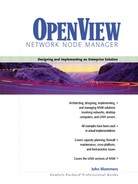How NNM Uses the Repeater and Bridge MIBs
Let’s follow the sequence of events as NNM goes about autodiscovery. The netmon daemon reads a router name from its seedfile, polls it, and finds a new interface. The appropriate subnet is added to the topology database. Since the router is in the management domain, so are all its subnets, and the new subnet is put in the managed state. A segment with the unique name Segment1 is created and a router icon is placed inside, representing the interface on that subnet.
As new IP addresses are discovered, perhaps from the router’s ARP cache, those that happen to have an IP address on the new subnet are placed in Segment1. When a new repeater or switch is discovered, it is polled to determine how many interfaces it has, and then the repeater or bridge MIB is read to harvest Ethernet (a.k.a MAC) addresses and the ports they are located on. If any of the devices in Segment1 have a MAC address found in the switch, a new segment is created, and the device is moved from Segment1 to the new segment.
As more switches and repeaters are discovered, ovw will lay them out as accurately as possible. As long as all the switches, bridges, and repeaters are assigned IP addresses in the same subnet, the layout will be accurate. If the router interface in our example is configured with secondary addresses, and if some of the switches, repeaters, and bridges are assigned IP addresses on all of them, then autolayout will not be able to accurately create the topology map. This is because ovw inherently discovers an IP subnet hierarchy. If a switch, bridge, or repeater does not support the repeater or bridge MIBs, then the layer 2 representation inside the subnet won’t be accurate. Nonconforming devices will appear to have just one interface. Devices connected to them will remain on Segment1. For that reason, it behooves the NNM administrator to pay special attention to Segment1 in all subnets in search of nonconforming network devices.
Note that if NNM is configured with the incorrect community string for a switch, bridge, or repeater, then there’s no indication its network equipment and the icon will be left in Segment1.
NNM will poll the interface MIB for devices to obtain the extended interface name to obtain the slot and port numbers of each segment. The user can right-click a connection symbol to display this information.
